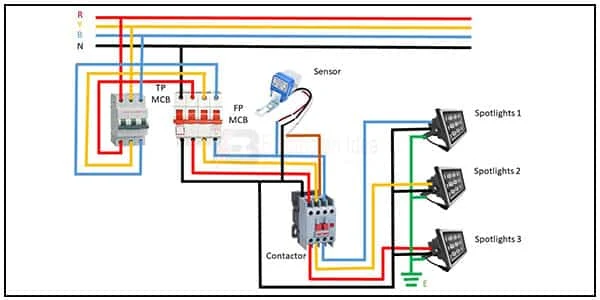Spotlights with photo control connection:
This diagram shows how to make Spotlights With Photo Control Connection. In this circuit, we use a TP MCB ( Tripple Pole Minature Circuit Breaker ), an FP MCB ( Four Pole Minature Circuit Breaker ), a photocell sensor, a magnetic contactor, and 3 phase spotlight. First, we need to connect the TP MCB, then connect FP MCB with TP MCB, then connect the Sensor and magnetic contactor with FP MCB, then connect all spotlights with the contactor.
Diagram of Spot lights wiring:
Components Need for this Project:
You can get the components from any of the sites below:
- TP MCB [See Buy Click Amazon]
- FP MCB [See Buy Click Amazon]
- Contactor [See Buy Click Amazon]
- Photocell Sensor [See Buy Click Amazon]
- Light [See Buy Click Amazon]
Read Also:
Components used to make the Single phase Spot light wiring:
01. TP MCB
 |
| Fig 2: TP MCB |
Three wires can be controlled by a triple pole MCB. Triple pole MCB circuit breakers are generally used in three-phase lines. A triple-pole MCB circuit breaker has three wires at its input and three wires at its output. But one can use this circuit breaker in a single-phase line. TP MCB widely used in industries. The reason is that it has three poles. And this TP circuit breaker is used to provide three-phase and three-phase connections. A neutral is not normally used in three-phase lines. But a 4-pole MCB circuit breaker is used if needed.
02. FP MCB
 |
| Fig 3: FB MCB |
Four pole MCCB for Four wires connections, the one additional Four pole for neutral wire connection so that between neutral and any of the other three will supply. It is used where is the possibility of a high neutral current (due to unbalanced loads and /or Third and multiple Third harmonics current etc) and Neutral / Earth Protection is provided on Neutral. Four Pole Circuit Breakers Have advantages in the case When one of the Poles of the Device will get Damaged, and they also provide Isolation from neutral voltage.
03. Contactor
 |
| Fig 4: Contactor |
A magnetic contactor is an electrical device used for load control, automation, and protection. It is much like a magnetic reel. However, relays are generally used for low power and voltage, on the other hand, when we think of high power, these heavy-duty contractors only come to mind. It basically works by switching the load on and off. It has 3 terminals whose inputs are denoted as L1, L2, L3, and outputs as T1, T2, and T3. The circuit of the load is made in automation mode or protection using auxiliary contacts. It has two types of terminals. 1) Normally Open (NO). 2) Normally Closed (NC)
04. Photocell Sensor
 |
| Fig 5: Photocell Sensor |
An Automatic Day Night Light Sensor Switch can Switch on Any Electrical Device Automatically When Dark Falls And Switch off in the Morning Automatically. This Night light With an Energy-Efficient LED (Light Emitting Diode) can be Plugged into the Socket and has a light sensor so that the lamp switches on automatically when it gets dark. This is a Photo Technology-Based automatic sensor switch for 220V AC mains, which can be Widely Used in Street Lights, Factories, Gardens, Shops, Etc., and Other Places for Automatic Lighting. Turns ON the Light in the Dark & Turns OFF in The Light.
05. Light
 |
| Fig 6: Light |
CFLs work in a completely different way from ordinary lamps, they work by using a different process called fluorescence rather than generating light from heat. A typical light bulb wastes 90% of energy and converts only 10% of energy into light, this is where CFL has the biggest advantage. CFL- Curved or conical glass tube filled with argon and a small amount of mercury vapor. The inner wall of the glass is coated with fluorescent material. CFL- It is manufactured using the principle of creating fluorescent light. CFL- Originally white in color but now the construction and use of CFLs producing colored light has become popular.
Thank You for visiting the website. Keep visiting for more Updates.


Post a Comment
Do leave your comments